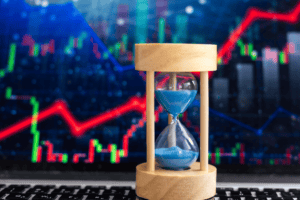You want to grow your wealth on your terms, and investing in the stock market is an excellent way to do that. While having a diversified portfolio is a smart move, it’s also important to understand specific aspects of investing, such as buying stocks that enable you to receive dividend payments. This will help you answer questions like “Can you live off dividends?” so you can plan wisely for retirement.
In this blog post, we’ll explore the idea of living off dividends and the concept of a dividend ladder to help you determine if it’s the right approach for you. We’ll also cover some key tax considerations for dividend investors and how these vary depending on which state you live in. Finally, we’ll address some frequently asked questions about dividends.
What is a dividend?
A dividend is a sum of money that a corporation pays regularly to its shareholders. The money is paid out of the company’s profit and is adjusted on a regular basis. If you own a stock that pays dividends, for example, Bank of America or Coca Cola, you’ll receive dividend payments from these corporations, typically on a quarterly basis. The amount varies, but it is usually around 1 to 5% of the share value. As a company’s profits grow, your dividend income will also increase.
Many investors use dividends to generate cash flow. One way to do this is by creating a dividend ladder in your investment portfolio. In this case, you could buy 20 different stocks that all pay dividends, such as Apple, Comcast, and General Electric. These stocks will pay you different amounts of money at various times of the year. If you have enough of these stocks in your portfolio and receive enough money from them, they could cover your income needs.
Can you live off dividends?
Have you ever wondered, “How much money do you need to live off dividends?” The answer varies depending on your financial situation, but it is possible to retire off dividends.
The first step is to determine how much income you’ll need to meet your spending goals. This is a little tricky, as you’ll have to factor taxes into the equation. It gets even trickier with dividends. You could pay as little as 0% in taxes on “qualified dividends” and up to 35% or more on “nonqualified dividends.” we’ll define these terms and delve further into this issue later on in this article.
Once you’re clear on your income needs, you’ll need to create a portfolio that includes dividend paying stocks. The companies that typically pay dividends are usually large, well-established corporations with consistently high profits. it’s a good idea to buy 20 or more dividend paying stocks rather than just one. This way, you’ll minimize the risk to your portfolio if the single stock you’re relying on for dividend income takes a nosedive. A good rule of thumb is to hold no more than 5% of your portfolio in one stock.
Then, determine whether the dividend payments you’ll receive from the various corporations in your portfolio will be enough to support your income in retirement. Dividend payments generally equal 1% to 4% of the stock’s share price. If you build a dividend ladder that pays you 2.5% each year, you would need to invest $1 million to receive $25,000 in dividend payments per year. Don’t forget about the taxes we mentioned earlier, as they can put a dent in the income you receive.
Why is diversification important?
While dividend-paying stocks should be a part of your investment portfolio, they shouldn’t be its only element. That would be akin to putting all your eggs in one basket.
Dividend-paying stocks are attractive because they provide an income stream. They tend to perform differently than growth stocks that don’t pay dividends, in that they may be less volatile and their stock price can be more stable since it’s tied to an income stream. However don’t get lulled into thinking this is a risk-free investment; it is not!
As we mentioned, companies that pay dividends are often large enterprises. In addition, their stocks are often value stocks as opposed to growth stocks. This means that the company has a low price-to-book ratio, typically has a high dividend yield, and may be perceived to have a lower price than what it is worth.
In contrast, the worth of a growth stock is based on projections that the company will grow significantly over time. This kind of stock typically has a higher price-to-earnings ratio, and investors may be willing to pay a higher price to purchase it. If a stock’s worth relies purely on growth, it might be more volatile due to the lack of income stream and more unknowns.
“An example of a value stock would be a bank such as JPMorgan Chase (JPM), while key growth is often found in the technology space such as Google (GOOG),” according to Investopedia. “The decision to invest in growth vs. value stocks is ultimately left to an individual investor’s preference, as well as their personal risk tolerance, investment goals, and time horizon.”
We couldn’t agree more! So, where does that leave dividend investors?
Dividends: A Common Misconception
Given the characteristics of dividend-paying stocks, many investors believe they’re building a safer portfolio by purchasing all dividend-paying stocks that can generate income over time to fund a spending need. Due to low yields that traditional fixed income has provided over the last decade, investors have sought after ways to improve yield. In reality, however, this doesn’t mean their portfolio is truly safe or that it’s generating the best returns possible.
You could end up adding risk to your portfolio or missing out on investment returns if you only invest in dividend-paying stocks. These are typically large cap stocks, which only capture the returns of that particular asset class.
If the large cap asset class performs poorly during a given quarter of the year and you don’t have exposure to other asset classes like small cap and international stocks, you may miss out on additional returns. Even if your dividend-paying stocks perform normally and continue to generate their regular rate of return (for example, 3%), that’s all you’ll receive from those investments. Alternatively, if your portfolio contained growth companies that earned 20% in a given quarter, you’d benefit from much higher returns.
The key takeaway here is that just because dividend stocks provide you with an income stream, it doesn’t mean they won’t decrease in value. Dividend stocks can and have underperformed growth stocks at various times in the history of the stock market.
Dividends: Potential Issues And Solutions
Be aware that if any individual stock you hold drops significantly in price or stops paying dividends, you could end up in trouble. For example, Bank of America’s stock price dropped from $54 per share to $3 per share, and the company reduced its dividend, during the Great Recession of 2008. If you were counting on this high-dividend stock at that time, you’d have found yourself in a tough situation, maybe even having to make significant changes to your lifestyle.
A better approach to structuring your portfolio is to invest money in both large and small cap stocks, as well as U.S. and international companies and varying types of fixed income. This way, you can reduce your overall portfolio risk and you might even earn more money. Think of it as total portfolio return. In addition, even though some of your stocks may not pay dividends, their overall performance could be higher.
Key Tax Considerations For Dividend Investors
Tax planning is an essential part of your overall financial plan, and understanding the tax implications of holding various types of investments in your portfolio is critical to success. Here are three main points to keep in mind:
1. Dividend income can be taxed.
Because dividend income is taxable, you’ll want to factor in tax considerations if you’re planning to own dividend-paying stocks.
If you hold a stock that pays dividends (or several that do), you’ll have to pay taxes on those dividend payouts at some point. This is not necessarily a bad thing; it’s just something to keep in mind as part of your budget.
If you’re in a high tax bracket, you’ll want to be careful about how much additional taxable income you generate through dividend-paying stocks. Beyond a certain point, a dividend ladder might be counterproductive. For instance, if you hold a stock that does not pay dividends and it goes up in value, you won’t have to pay capital gains tax on that stock until you sell it.
2. Qualified and nonqualified dividends are taxed differently.
We referred to this point earlier; let’s dive into it in more detail.
Qualified dividends are taxed at federal capital gains rates, having met IRS requirements for eligibility. Nonqualified dividends don’t meet the IRS requirements, and they are taxed at your regular income tax rate (the one pegged to your tax bracket). The eligibility requirements are keyed to other aspects of an investment besides its value. They might, for example, require you to hold the investment for a specified minimum length of time.
Bearing in mind that capital gains tax rates range from 0% to 20% depending on your income level, you’ll want to consider how qualified dividends may be advantageous in certain situations. For example, if you have taxable income in the 12% bracket, your capital gains tax will be 0%. In that instance, it would be better for you to have qualified dividends in your portfolio rather than nonqualified. If you have nonqualified dividend income and you happen to be in a 32% tax bracket, that’s the rate you’ll pay on the dividend income.
3. Your dividends will be taxed differently depending on where you reside.
In the U.S., tax codes vary from state to state. For example, if you live in Florida, the state does not tax income, including dividend income. (The income will be subject to federal taxes).
In contrast, If you live in Maryland and you have a dividend portfolio, you will be taxed by both the federal government and the state.
The kicker here is that most states don’t differentiate between qualified and nonqualified dividends, so your dividend income from qualified dividends could be taxed at a high state level (potentially higher than the federal capital gains tax).
4. You can defer tax on dividends depending on where you hold the stocks.
If you purchase $10,000 worth of Google stock and keep it in an individual retirement account (IRA), and that stock pays a dividend, the funds will automatically accrue to your IRA rather than to your personal bank account. You won’t have to pay tax on that money until you withdraw it from the IRA and deposit it in your personal account.
This tax strategy can be beneficial because your dividend income will be sheltered in the IRA as it accumulates. It would be a good scenario if, for example, you’re 55 years old and want a dividend-paying portfolio but you’re still earning a high salary. Keeping the portfolio in an IRA could allow it to generate substantial tax-deferred income. Once you retire, you can pull the money out (at which point it becomes taxable, but since your taxable income may be lower you will pay a lower tax rate).
Dividends: Frequently Asked Questions
1. Should I hold dividend-paying stocks?
Yes. While every investment portfolio is different, reflecting such factors as your risk tolerance level and time horizon for investing, a large and well diversified portfolio will naturally contain dividend-paying stocks. At Curio Wealth, we believe you should receive returns from both growth in the value of stocks and from dividends.
2. Are dividend-paying stocks as safe as bonds?
No. And since they aren’t, it’s important to consider including other income-producing investment vehicles in your portfolio as well. These might include bonds, fixed income investments, and certificates of deposit, for example. Bonds might pay only 2% income, whereas a dividend might pay up to 5%, but a bond is a much safer type of investment because it is backed by the assets of the company that issued the bond (or in the case of a certificate of deposit, there is FDIC insurance; and a U.S. Treasury bond is backed by the Federal Government).
3. How often are dividends paid out?
Typically, on a quarterly basis, but sometimes semi-annually.
4. How are dividends taxed?
Dividends can be taxed at different rates depending on the type of dividend (qualified vs. nonqualified) and other income sources you may have.
5. Can a company stop paying a dividend?
Yes. This is doubly problematic (beyond losing your source of income from the dividend), because if a company gets into financial trouble and doesn’t have cash flow to pay dividends, investors will be less willing to pay the stock price. Hence, the value of the stock will decrease. The way to minimize this risk is to hold a large number of dividend-paying stocks.
Curio Wealth: Your Partner On The Investing Journey
At Curio Wealth, we want to help you minimize risk while still achieving returns and enjoying a stress-free retirement. Creating a diversified rather than a concentrated portfolio is the best way to increase your returns. If you’d like to learn more about our investment philosophy and how it could work for you, schedule a call with us today.







